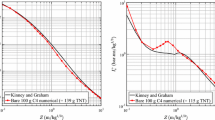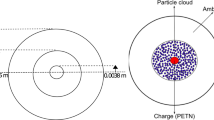Abstract
A dense, two-phase numerical methodology is used to study the mixing layer developing behind the detonation of a heterogeneous explosive charge, i.e., a charge comprising of a high explosive with metal particles. The filtered Navier–Stokes equations are solved in addition to a sub-grid kinetic energy equation, along with a recently developed Eulerian–Lagrangian formulation to handle dense flow-fields. The mixing layer resulting from the post-detonation phase of the explosion of a nitromethane charge consisting of inert steel particles is of interest in this study. Significant mixing and turbulence effects are observed in the mixing layer, and the rms of the radial velocity component is found to be about 25% higher than that of the azimuthal and zenith velocity components due to the flow being primarily radial. The mean concentration profiles are self-similar in shape at different times, based on a scaling procedure used in the past for a homogeneous explosive charge. The peak rms of concentration profiles are 23–30% in intensity and decrease in magnitude with time. The behavior of concentration gradients in the mixing layer is investigated, and stretching along the radial direction is observed to decrease the concentration gradients along the azimuth and zenith directions faster than the radial direction. The mixing and turbulence effects in the mixing layer subsequent to the detonation of the heterogeneous explosive charge are superior to that of a homogeneous explosive charge containing the same amount of the high explosive, exemplifying the role played by the particles in perturbing the flow-field. The non-linear growth of the mixing layer width starts early for the heterogeneous explosive charge, and the rate is reduced during the implosion phase in comparison with the homogeneous charge. The turbulence intensities in the mixing layer for the heterogeneous explosive charge are found to be nearly independent of the particle size for two different sizes considered in the initial charge. Overall, this study has provided some useful insights on the mixing layer characteristics subsequent to the detonation of heterogeneous explosives, and has also demonstrated the efficacy of the dense, multiphase formulation for such applications.
Similar content being viewed by others
References
Zhang, F., Frost, D.L., Thibault, P.A., Murray, S.B.: Explosive dispersal of solid particles. Shock Waves 10, 431–443 (2001)
Frost, D.L., Ornthanalai, C., Zarei, Z., Tanguay, V., Zhang, F.: Particle momentum effects from the detonation of heterogeneous explosives. J. Appl. Phys. 101, 113529 (2007)
Balakrishnan, K., Nance, D.V., Menon, S.: Simulation of impulse effects from explosive charges containing metal particles. Shock Waves 20, 217–239 (2010)
Balakrishnan, K.: On the high-fidelity simulation of chemical explosions and their interaction with solid particle clouds. PhD Thesis, Georgia Institute of Technology (2010)
Lanovets, V.S., Levich, V.A., Rogov, N.K., Tunik, Y.V., Shamshev, K.N.: Dispersion of the detonation products of a condensed explosive with solid inclusions. Combust. Expl. Shock Waves 29(5), 638–641 (1993)
Taylor, G.I.: The instability of liquid surfaces when accelerated in a direction perpendicular to their planes. Proc. R. Soc. Lond., A Math. Phys. Sci. 201, 192–196 (1950)
Brode, H.L.: Blast wave from a spherical charge. Phys. Fluids 2(2), 217–229 (1959)
Richtmyer, R.D.: Taylor instability in a shock acceleration of compressible fluids. Commun. Pure Appl. Math. 13, 297–319 (1960)
Kuhl, A.L.: Spherical mixing layers in explosions. Dynamics of Exothermicity, pp. 291–320. Gordon and Breach Publishers (1996)
Kuhl, A.L., Ferguson, R.E., Oppenheim, A.K.: Gasdynamic model of turbulent exothermic fields in explosions. Prog. Astronaut. Aeronaut. 173, 251–261 (1997)
Balakrishnan, K., Genin, F., Nance, D.V., Menon, S.: Numerical study of blast characteristics from detonation of homogeneous explosives. Shock Waves 20, 147–162 (2010)
Balakrishnan, K., Menon, S.: On the role of ambient reactive particles in the mixing and afterburn behind explosive blast waves. Combust. Sci. Tech. 182(2), 186–214 (2010)
Balakrishnan, K., Menon, S.: On turbulent chemical explosions into dilute aluminum particle clouds. Combust. Theory Model. 14(4), 583–617 (2010)
Balakrishnan, K., Ukai, S., Menon, S.: Clustering and combustion of dilute aluminum particle clouds in a post-detonation flow field. Proc. Combust. Inst. 33(2), 2255–2263 (2011)
Frost, D.L., Zarei, Z., Zhang, F.: Instability of combustion products interface from detonation of heterogeneous explosives. In: 20th International Colloquium on the Dynamics of Explosions and Reactive Systems, Montreal, Canada (2005)
Menon, S., Patel, N.: Subgrid modeling for simulation of spray combustion in large-scale combustors. AIAA J. 44(5), 709–723 (2006)
Patel, N., Menon, S.: Large-eddy simulation of swirl-stabilized spray combustion. AIAA paper 2006-154 (2006)
Genin, F., Menon, S.: Studies of shock/turbulent shear layer interaction using large-eddy simulation. Comput. Fluids 39(5), 800–819 (2010)
Genin, F., Menon, S.: Dynamics of sonic jet injection into supersonic crossflow. J. Turbul. 11(4), 1–30 (2010)
Oefelein, J.C.: Large eddy simulation of turbulent combustion processes in propulsion and power systems. Prog. Aerosp. Sci. 42, 2–37 (2006)
White, F.M.: Viscous Fluid Flow. McGraw-Hill (1991)
Fureby, C., Moller, S.I.: Large-eddy simulations of reacting flows applied to bluff-body stabilized flames. AIAA J. 33, 2339–2347 (1995)
Dobratz, B.M.: LLNL Handbook of Explosives. LLNL Publication UCRL-52997, Lawrence Livermore National Laboratory (1985)
Zukas, J.A., Walters, W.P.: Explosive Effects and Applications. Springer (1998)
Cowperthwaite, M.: Significance of some equations of state obtained from shock-wave data. Am. J. Phys. 34(11), 1025–1030 (1966)
Schwer, D.A., Kailasanath, K.: Numerical simulations of the mitigation of unconfined explosions using water mist. Proceedings of the Combustion Institute 31(2), 2361–2369 (2007)
Abgrall, R., Saurel, R.: Discrete equations for physical and numerical compressible multiphase mixtures. J. Comput. Phys. 186, 361–396 (2003)
Chinnayya, A., Daniel, E., Saurel, R.: Modelling detonation waves in heterogeneous energetic materials. J. Comput. Phys. 196, 490–538 (2004)
Toro, E.F.: Riemann Solvers and Numerical Methods for Fluid Dynamics. Springer (1999)
Snider, D.M.: An incompressible three-dimensional multiphase particle-in-cell model for dense particle flows. J. Comput. Phys. 170, 523–549 (2001)
Patankar, N.A., Joseph, D.D.: Modeling and numerical simulation of particulate flows by the Eulerian–Lagrangian approach. Int. J. Multiph. Flow 27, 1659–1684 (2001)
Akhatov, I.S., Vainshtein, P.B.: Transition of porous explosive combustion into detonation. Combust. Explos. Shock Waves 20(1), 63–69 (1984)
Baer, M.R., Nunziato, J.W.: A two-phase mixture theory for the deflagration-to-detonation-transition (DDT) in reactive granular materials. Int. J. Multiph. Flow 12(6), 861–889 (1986)
Gokhale, S.S., Krier, H.: Modeling of unsteady two-phase reactive flow in porous beds of propellant. Prog. Energy Combust. Sci. 8, 1–39 (1982)
Youngs, D.L., Williams, R.J.R.: Turbulent mixing in spherical implosions. Int. J. Numer. Methods Fluids 56, 1597–1603 (2008)
Liu K., Haworth, D.C.: Large-eddy simulation for an axisymmetric piston-cylinder assembly with and without swirl. Flow Turbulence Combust. 85, 279–307 (2010)
Pope, S.B.: Ten questions concerning the large-eddy simulation of turbulent flows. New J. Phys. 6(35), 1–24 (2004)
Kannan, R., Wang, Z.J.: A Study of viscous flux formulations for a p-multigrid spectral volume Navier Stokes solver. J. Sci. Comp. 41(2), 165–199 (2009)
Kannan, R., Wang, Z.J.: LDG2: a variant of the LDG viscous flux formulation for the spectral volume method. J. Sci. Comput. Published online. doi:10.1007/s10915-010-9391-0 (2010)
Kannan, R., Wang, Z.J.: The direct discontinuous Galerkin (DDG) viscous flux scheme for the high order spectral volume method, Comput. Fluids 39(10), 2007–2021 (2010)
Liang, C., Kannan, R., Wang, Z.J.: A p-multigrid spectral difference method with explicit and implicit smoothers on unstructured triangular grids. Comput. Fluids 38(2), 254–265 (2009)
Freund, J.B., Moin, P., Lele, S.K.: Compressibility effects in a turbulent mixing layer. Part 2. Mixing of a passive scalar. J. Fluid Mech. 421, 269–292 (2000)
Zhang, Q., Graham, M.J.: A numerical study of Richtmyer–Meshkov instability driven by cylindrical shocks. Phys. Fluids 10(4), 974–992 (1998)
McNesby, K.L., Homan, B.E., Ritter, J.J., Quine, Z., Ehlers, R.Z., McAndrew, B.A.: Afterburn ignition delay and shock augmentation in fuel rich solid explosives. Propellants Explos. Pyrotech. 35, 57–65 (2010)
Author information
Authors and Affiliations
Corresponding author
Rights and permissions
About this article
Cite this article
Balakrishnan, K., Menon, S. Characterization of the Mixing Layer Resulting from the Detonation of Heterogeneous Explosive Charges. Flow Turbulence Combust 87, 639–671 (2011). https://doi.org/10.1007/s10494-011-9349-9
Received:
Accepted:
Published:
Issue Date:
DOI: https://doi.org/10.1007/s10494-011-9349-9




